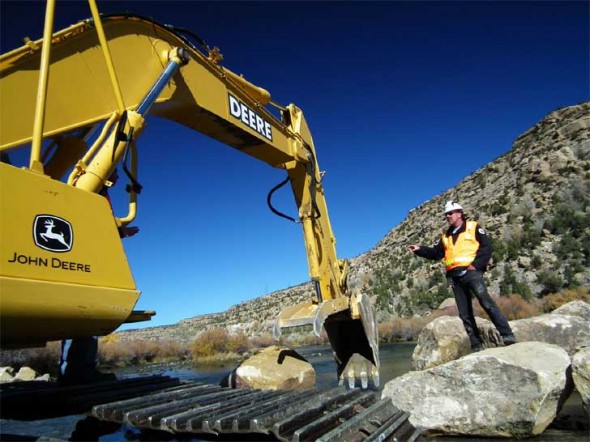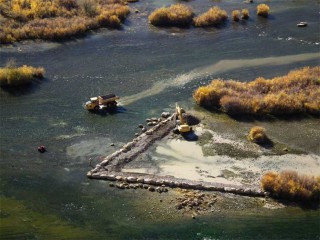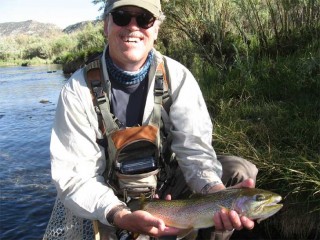
Marc Wethington, San Juan River Fisheries Biologist for the New Mexico Department of Game and Fish oversees installation of habitat improvements.
The popular Braids fishing area of the San Juan River below Navajo Dam will remain off-limits to anglers until sometime in December 2011 as construction crews finish installing fish habitat improvements and sediment controls.
“It’ll be worth the wait,” says Marc Wethington, San Juan Fisheries Biologist for the New Mexico Department of Game and Fish (NMDGF). “We should see immediate improvements to the fishing up here once they’re done.”
The Braids area features many small islands interspersed by channels where the water is shallow and the trout have only a limited number of places to live.
Improvements to the habitat there should increase the area’s trout holding capacity and angling success, Wethington said.
Flows on the river have also been dropped from normal levels of about 500 cubic-feet-per-second (CFS) to 350-cfs to allow heavy equipment to work within the riverbed.
Some anglers may like the lower flow as it opens up some areas of the river to easier wading and fishing.
So far in the recent weeks crews have completed much of the work on a new catchment basin at the base of Rex Smith Wash which is designed to retain and redirect storm runoff to prevent silt and sediment from washing directly into the river.
In previous years heavy flows from the wash were responsible for silting up the popular Kiddie and Texas holes and negatively impacting fish habitat there and further downstream.
At one time runoff from the wash used to flow harmlessly out across what is now the Texas Hole parking lot which was constructed by State Parks to accommodate anglers who pay a $5 a day user’s fee.
But after flooding threatened vault toilets installed there State Parks elected to construct a dirt berm along the edge of the parking lot to channel the wash’s flow directly into the river.
The retention pond should now alleviate that problem and end a decade long effort to address it, Wethington said.
Work still to be done to the retention pond includes excavation of the hillside through which Rex Smith Wash flows so runoff can be better directed into the catchment basin, Wethington said.
Outflow from the retention pond will then be directed upstream into a heavily vegetated, marsh area where silt and sediment can settle and the water filter out before draining into the river, Wethington noted.
“The planning engineers on this project have extensive past experience in storm water control,” Wethington said of the pond. “I’m very confident in its design.”
But anglers will probably be more interested in another part of the project which includes remodeling the Braids area to provide more places for fish to live and anglers to stalk.
A mid-stream island is being built up and further out into the river’s flow to redirect more water into the Braids area and increase the depth.
Some side channels will be shut off and filled in while several existing islands will also be consolidated to implement the plan.
Numerous deep holes will then be dug out of the bedrock to provide future homes for fish and willows and other natural vegetation will be planted to return the area to a natural appearance.
“In a few years you shouldn’t even be able to notice the work we’ve done,” Wethington said.
The project is the latest of several habitat improvement projects on the river designed to enhance conditions for trout and anglers alike while also serving as a hedge against the possibility of lower water flows in the future.
Riverbend Engineering of Albuquerque and Pagosa Springs, Colo., handled planning for the project while AUI of Albuquerque is providing construction services with assistance from Aquatic Consultants of Albuquerque, Wethington said.
Wethington, a New Mexico Highlands University graduate, has been NMDGF’s Fisheries Biologist on the San Juan River since he joined the wildlife agency back in 1995.
His work on behalf of the river and the public is commendable, says his boss, Mike Sloan, Chief of the Fisheries Division for NMDGF.
State Game Commission Chairman Jim McClintic also provided much needed political support to see the project through, Sloan noted.
The $350,000 project cost was funded in part with $250,000 earmarked by former Governor Bill Richardson’s administration. Another $100,000 in federal sport fish restoration funds was also used to meet costs. Those funds are generated through excise taxes on fishing tackle, motor boat fuel and other sporting goods, Sloan said.
Crews will be working long shifts Monday through Thursdays and are expected to finish well before their deadline of January 7, Wethington said.
Anglers are prohibited from entering through the closed area of the river during construction and will be ejected from the park if warranted, Wethington said.
Anglers are eagerly waiting to see the results of this latest San Juan River project, says Reel Life Fly Shop Manager, Toner Mitchell, who also serves as current president of the Truchas Chapter of the Trout Unlimited.
“This kind of a marquee project shows people we care about this resource,” he said. “And I think it’s going to make the Braids a whole lot more fun to fish.”
The San Juan River is New Mexico’s premier trout fishing destination bringing in an estimated $30 to $40 million annually to the state’s economy.
The river boasts an estimated 70,000 trout inhabiting the first four miles of river below Navajo Dam where catch and release and two flies only rules exist.
Angler survey results show the river sustains an average of 140 anglers a day who each catch just over a fish an hour averaging 16 inches in length. About 6 percent of those anglers report having caught a trout over 20 inches long, Wethington said.





